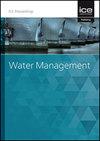Forecasting river daily discharge using decision tree and time series methods
IF 0.9
4区 工程技术
Q3 ENGINEERING, CIVIL
Proceedings of the Institution of Civil Engineers-Water Management
Pub Date : 2023-10-13
DOI:10.1680/jwama.22.00079
引用次数: 0
Abstract
River floods disrupt communication and transportation networks, damage buildings and infrastructure, destroy agricultural products and livestock, cause capital losses and endanger human life. Accurate and proper flood prediction and forecasting are major challenges in hydrology and water resources management. The aim of this study was to forecast and estimate the daily flows of three rivers in Iran using four tree-based data-mining methods, two ensemble bagging methods and the stochastic time series model Arima (auto-regressive integrated moving average). A comparison of these different methodologies is the main contribution of this work. Five statistical measures were used to evaluate the accuracy of these models based on 4 years of daily discharge flow data. The hold-out method was used to divide the data into training (70%) and testing (30%) sets. It was found that the ensemble tree-based chi-square automatic interaction detector provided the most precise forecasts. The overall results indicate that the data-mining methods of ensemble models and tree-based models improved the average accuracy of the models by 25.0% and 15.5% compared with the stochastic Arima model, respectively, indicating the superiority of their potential in capturing the non-linear behaviour of flow discharges.利用决策树和时间序列方法预测河流日流量
河流洪水扰乱交通网络,破坏建筑物和基础设施,毁坏农产品和牲畜,造成资金损失,危及生命。准确、适当的洪水预报和预报是水文和水资源管理的主要挑战。本研究的目的是利用四种基于树的数据挖掘方法、两种集合装袋方法和随机时间序列模型Arima(自回归综合移动平均)来预测和估计伊朗三条河流的日流量。对这些不同方法的比较是这项工作的主要贡献。基于4年的日流量数据,采用5个统计指标来评价模型的准确性。采用hold-out方法将数据分为训练集(70%)和测试集(30%)。研究发现,基于集合树的卡方自动交互检测器提供了最精确的预测。总体结果表明,与随机Arima模型相比,集成模型和基于树的模型的数据挖掘方法的平均精度分别提高了25.0%和15.5%,表明它们在捕获流量非线性行为方面具有优势。
本文章由计算机程序翻译,如有差异,请以英文原文为准。
求助全文
约1分钟内获得全文
求助全文
来源期刊
CiteScore
2.10
自引率
0.00%
发文量
28
审稿时长
6-12 weeks
期刊介绍:
Water Management publishes papers on all aspects of water treatment, water supply, river, wetland and catchment management, inland waterways and urban regeneration.
Topics covered: applied fluid dynamics and water (including supply, treatment and sewerage) and river engineering; together with the increasingly important fields of wetland and catchment management, groundwater and contaminated land, waterfront development and urban regeneration. The scope also covers hydroinformatics tools, risk and uncertainty methods, as well as environmental, social and economic issues relating to sustainable development.

 求助内容:
求助内容: 应助结果提醒方式:
应助结果提醒方式:


